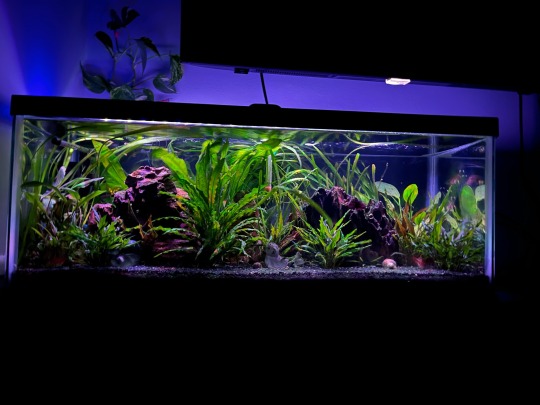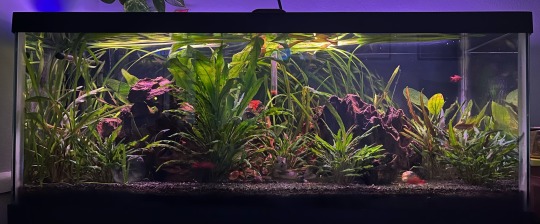#planted tanks
Explore tagged Tumblr posts
Text

cozy vibes
183 notes
·
View notes
Text

He lurks
70 notes
·
View notes
Text
Benefits of collecting your own aquascape materials:
Save a lot of money
Walk down the street with a large cobble in your hand, nobody catcalls you.
12 notes
·
View notes
Text
I mostly write about organisms and not the principles of fishkeeping. However people often ask me about two related phenomena, cycling and stocking. Aquariums are safe for fish and other animals because of the nitrogen cycle. This is what determines, moreso than the water volume, the carrying capacity of the tank. But many people seem to be confused - what is the nitrogen cycle?
'Cycling' refers to the cycle by which the toxin ammonia, which is excreted as waste by organisms, before it is turned to nitrite and then to nitrate by biological actors. In aquarist parlance 'cycling' refers to the process and duration of time, during which the nitrogen cycle becomes established and stable. Properly the cycle continues throughout the operation of the aquarium.
Ammonia, which contains nitrogen, is the principal excretory product of living animals, and they void it because it is a toxic byproduct of their own metabolic processes. Human urination is an example of a way in which animals lose excess ammonia, but other kinds of animal may excrete ammonia by means of different methods.
Fortunately other organisms can find a positive use for ammonia, which animals don't want. Their own metabolisms create nitrite from the ammonia they intake, by breaking it down and adding oxygen to the nitrogen. Then yet more microscopic organisms convert the nitrite to the similarly named and chemically related nitrate, which must also be maintained at low levels, but is far less harmful. Traces of nitrate are in fact beneficial to some aquarium organisms.
The nitrogen cycle originates from the decomposition of amino acid, and this is why test kits are available to test for dissolved organics, which are not themselves inherently harmful, but their buildup indicates strain upon the system. How much strain is acceptable depends on the kinds of animals that are living in the aquarium. There isn't really a single standard as to when there are too many dissolved organics, or even nitrate. But regular and sensibly proportionate water changes, help to keep both under control.
Because it involves the processes of different organisms, the nitrogen cycle is very obviously an ecological, as well as a chemical phenomenon. Both the natural processes of the cycle, and the technology by which the effects of the benign organisms are maximised, are known as biological filtration, or biofiltration. It is different from physical and chemical filtration, although the functions of filter media may overlap.
The good bacteria that are involved, colonise available surfaces throughout the aquarium. They are present on rocks and on substrates such as sand and gravel. Similarly they colonise sponges and various proprietary items such as 'bio balls'. At this point, I wish to explain the introductory principles of biofiltration, not to cover its different expressions. It is however worth pointing out, the more the better.
Stocking levels are problematic principally because the living animals themselves create strains upon the biofiltration. Furthermore they require inputs of food, excesses of which contribute to dissolved organics, and therefore the nitrogen cycle, when they are uneaten - thus, messy feeders create more bioload than other organisms, lowering the carrying capacity of the aquarium system.
Feeding behaviors thus determine the 'footprint' animals have on the biofiltration in their aquarium, moreso than their size. It is also the mass of an animal that contributes to its output of wastes, moreso than any single dimension, such as its total length. Another determinant is the metabolic rate of the animal in question, which determines the speed at which its wastes are generated and churned out into the water.
The nitrogen cycle is also why overfeeding is bad, because excess food must inevitably decompose. By definition, the aquarist can't be overfeeding, from the perspective of the nitrogen cycle, when the supplied food is being eaten; overfeeding as in overeating is a different problem. However if feeding your livestock and keeping them healthy begins to stress the cycle, then you have too much bioload in your aquarium.
Often in marine aquariums, 'live rock' and 'live sand' are mentioned. These terms mystify many people, although they are relevant to filtration. The rocks and sand in question are substrates already colonised by microscopic organisms, as play a role in the nitrogen cycle. All items already this colonised are thus 'live' biofiltration media.
Unfortunately there is a misconception that 'live' rock needs transporting from the sea. Such rock is shipped damp but emersed, killing benign and desirable organisms, and necessitating a period called 'curing' in which photosynthesizers are denied an energy source, and further mortality and decomposition ensues. The result is that only 'tough as boots' organisms survive, and some of these species are harmful to corals and such.
Clearly despite the appeal of 'live rock' as a ready made, natural reef, it's use is problematic and self defeating. A distinction just be made, between the use of 'living' filtration media, and the importation of artificially depauperate microenvironments for aquariums. It is better to take rock and sand from an established reef tank instead, to avoid unwanted guests. Although even impoverished live rock can introduce interesting and useful 'friends', these can arrive also from established, nuisance-free tanks
A counterpart to the use of live rock and sand in reef aquariums, is the Walstad style of freshwater aquarium. The Walstad type of tank is one in which living plants and soil substrates are employed instead of artificial filtration; more common than a strict Walstad setup, is a hybrid system that employs both naturalistic and 'normal' approaches in its running.
Sometimes it is said that planted tanks do not cycle, or that adding plants stops the cycle. Nothing could be further from the truth. True aquatic plants and the organisms called algae, play a role in the cycle, which is why algae bloom during the cycling period of a new aquarium, when the lighting is switched on. Adding plants to freshwater tanks, and macroalgae to marine aquariums, should be thought of as assisting the stabilisation of the nitrogen cycle.
#nitrogen cycle#ammonia#nitrite#nitrate#biological filtration#biofiltration#stocking level#overfeeding#dissolved organics#live rock#live sand#algae#plants#Walstad method#planted tanks#macroalgae
2 notes
·
View notes
Text

Like a wolf howling at a full moon
#planted aquarium#shrimpblr#shrimp#aquablr#fish#shrimposting#shrimpy#cherry shrimp#neocaridina#neocaridina davidi#nano tank
1K notes
·
View notes
Text



This vintage Garfield fish tank was such a rad find! Gonna cycle it for a few months and maybe add some teeny tiny shrimp.
2K notes
·
View notes
Text
Two male sparking gouramis showing off. Their colors are absolutely insane, I’m obsesseddddd
#sparkling gourami#aquarium community#freshwater aquarium#planted aquarium#fishblur#aquablr#planted tank#aquarium#the big tank
4K notes
·
View notes
Text
Skrunp video for the skrimp enjoyers out there
2K notes
·
View notes
Text
Apparently this is their new favourite spot.

#aquablr#bichirs#bichir#aquarium#planted aquarium#fishtank#planted tank#fishblr#fish#freshwater aquarium#polypterus delhezi#polypterus
585 notes
·
View notes
Text
shrim

sooo orang 😍🥰🧡
#shrimp#shrimpblr#aquarium#freshwater aquarium#fish tank#planted aquarium#planted tank#fishblr#aquablr#neocaridina shrimp#neocaridina
503 notes
·
View notes
Text


january 2023 vs january 2024
134 notes
·
View notes
Text

Mad about it.
12 notes
·
View notes
Text
I know I've been in this hobby a long-ass time, but I remember when you could get a whole box of tropical fish shipped overnight by Fed-Ex, for like, 30 bucks.
Now even a small box of live animals is, what, around $60 from most vendors?
It wouldn't even affect me that much if there were still plenty of smaller stores run by hobbyists, alternatives to the Big Box stores. There were five Mom and Pop aquarium shops when we moved to this area in the late 90s, plus a couple smaller pet store chains that had an aquarium section.
Now there's two, and both of the chains have dropped their aquarium sections.
There's no shortage of people in the hobby, in this area. But I'd have to drive out of state for the closest Society that holds monthly meetings. Meetings in a town hall have become Facebook groups, fundraising auctions have become online fish-swaps.
As the hobby evolves, so will aquarists.
20 notes
·
View notes
Text
With any substrate, things like phosphates, iron, and ammonia come to be gradually and naturally concentrated at the bottom. This is why reddish cyanobacterial blooms happen on the substrate, sometimes, in even marine tanks with perfect water parameters. Its also why the sudden, physical stirring of an established substrate, can rapidly affect the water chemistry as reported by test kits; when 'bad stuff' is immediately sent upwards in the water column, and thus back into solution, because formerly percolated chemicals and particles have been disturbed.
The way in which the saturated substrate has different chemical parameters to the water column up above, means that - for example - the phisphate levels of the aquarium water can suddenly (and negatively) be affected, should the substrate become disturbed, usually by the activities of the aquarist. Needless to say, any such stirring of the substrate must be regular and small scale, for example through the activities of 'live sand' infauna, and those of larger, burrowing ornamental animals, such as shrimp, gobies, echinoderms, and gastropods.
A similar misunderstanding of a substrate involves freshwater tanks, and the fear that 'muck' or detritus in the substrate makes undergravel filtration ineffective. In reality such detritus holds well the beneficial nutrients, that plants require and are able to access with their root systems. Dirty gravel or sand is thus excellent for plant growth, and coarser grains trap more wholesome muck. As with marine tanks, and for the same reason as described above, substrates should not be disturbed large scale if it can be avoided, whether or not an undergravel filter happens to be employed in the tank.
The accumulation of detritus within a gravel or sand substrate, and the processes and products of its decomposition, are (as they say) a rather integral working or feature, and not at all a ‘bug’ to be avoided. Aquaria cannot be spotless, and vacuuming activities should only ever be done lightly, or not at all - and if done at all, then only lightly spruced, and only from the surface of the sand or gravel. It is important that only the surface of the gravel should be disturbed if at all, or its utility for natural biofiltration will be compromised.
Returning to the subject of substrates and filtration; in marine aquariums, but rarely in freshwater tanks, people sometimes advocate what are called 'anoxic plenums' beneath the substrate - the so-called 'Monaco method'. The whole point is that, unlike the workings of undergravel filtration systems, water is not at all pumped through the space, making it a stable volume or 'void space' of water, that is deprived of dissolved oxygen - constituting a plenum. Plenums were once a huge idea in reefkeeping, following the famous aquarium scientist, Jean Jaubert.
However, it seems that the idea of the often imitated Monaco system, is actually based on misunderstood observations of phenomena taking place in aquariums, that have other scientific explanations. Related to the facts and fallacies surrounding the dubious plenum method, is the popular notion that sufficiently deep beds of sand used as a substrate, are in themselves similarly beneficial, thus rendering the creation of a plenum superfluous. Typically associated with marine and especially reef aquaria, these methods have some advocates as regards freshwater tanks.
Where water flow is absent throughout the substrate, there is a risk, however slim, that organic material might end up decomposing deep in the substrate, in a way producing accumulations of bacterial toxins alongside noxious smells - and a possibility that there could be mortalities should this filth be released unto desirable organisms. I have only ever experienced such smells after disturbing a settled substrate, and yet fortunately, there were no mortalities despite a sudden and downward shift in my water quality, that distressed the fish - you should get the picture by now, not to disturb the substrate, wether it is being used as a filter medium or not.
Now returning to the subject of plants in freshwater aquaria. Vascular plants (or tracheophytes) access nutrients via their roots, and natural selection has furnished different plants with different root systems for this purpose. Plants such as Echinodorus and Cryptocoryne are heavy root feeders, equipped with long and deeply penetrating roots, Such plants do better when they are planted in gravel than on sand, because gravel traps detritus better. A reverse flow variant of the undergravel system, would actually help to bring nutrients to the living and feeding plant roots.
#substrate#water chemistry#undergravel filtration#biofiltration#planted tanks#aquarium plants#cyanobacteria#detritus#deep sand beds#plenums#monaco method#gravel vacuums#decomposition
1 note
·
View note
Text

Even CNN is reporting the truth more now. But if you are held without being charged, you aren’t a prisoner, you’ve been kidnapped and are a HOSTAGE. And human rights organizations have said that the other 50%, who were charged, were mainly charged with throwing rocks, and that even most of that was made up.
For all the pro israel who came to my posts of Palestinian children celebrating their freedom, calling them terrorists and criminals. Israel is an occupation state, they don't need a reason to arrest you as long as you're Palestinian.
#so done with israelis calling Palestinian children terrorists when they've been arrested since they were younger than 13 & tortured & beaten#for no reason no charge or for throwing a rock at a military tank#not to mention the kids charged for stabbing when there's literally no proof which is why they're not allowed lawyers or trials#israeli soldiers would go as much as planting a knife in the scene which#i think is absolutely unnecessary since they can arrest people without any charge#palestine#gaza#israel#important#current events#free palestine#ethnic cleansing#free gaza#israel apartheid#israel is a terrorist state#israel is an apartheid state#cnn#world news
2K notes
·
View notes
Text

The shrimp are in there
#planted aquarium#fish#aquablr#aquarium#nano tank#shrimp#neocaridina davidi#neocaridina#cherry shrimp#shrimps#shrimpblr
991 notes
·
View notes